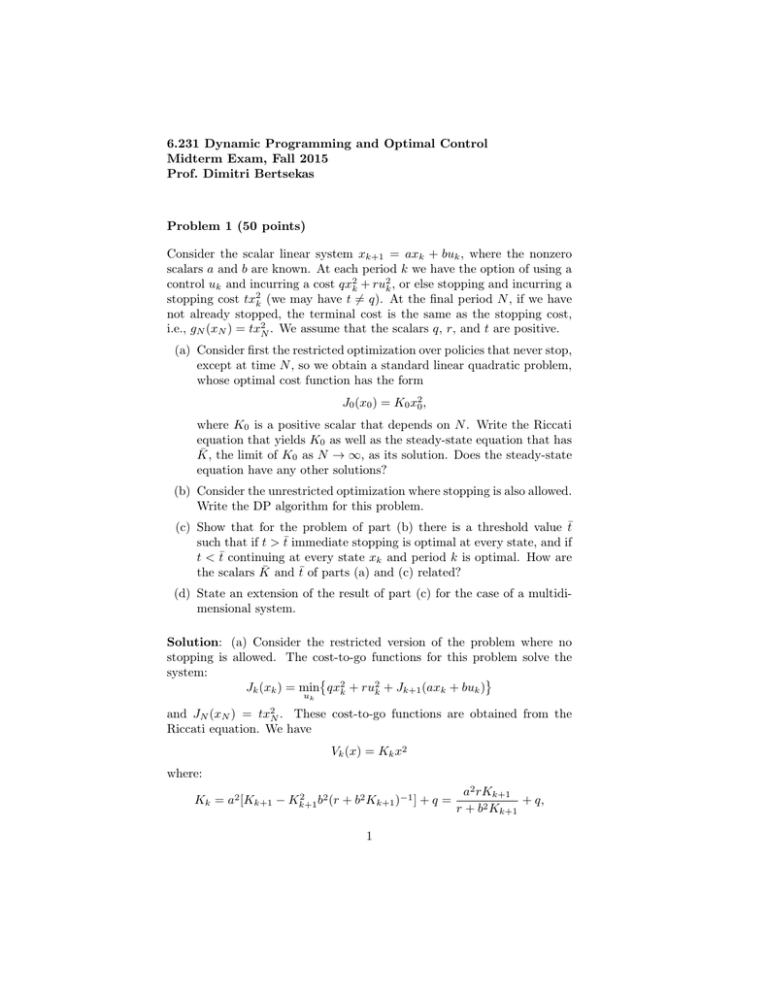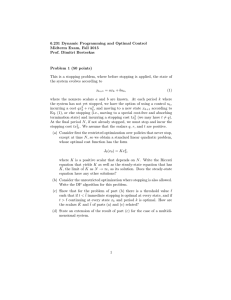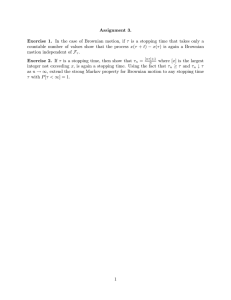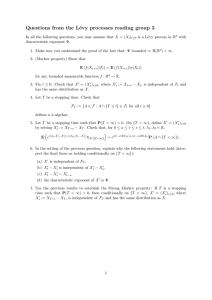6.231 Dynamic Programming and Optimal Control Midterm Exam, Fall 2015
advertisement

6.231 Dynamic Programming and Optimal Control Midterm Exam, Fall 2015 Prof. Dimitri Bertsekas Problem 1 (50 points) Consider the scalar linear system xk+1 = axk + buk , where the nonzero scalars a and b are known. At each period k we have the option of using a control uk and incurring a cost qx2k + ru2k , or else stopping and incurring a stopping cost tx2k (we may have t = 6 q). At the final period N , if we have not already stopped, the terminal cost is the same as the stopping cost, i.e., gN (xN ) = tx2N . We assume that the scalars q, r, and t are positive. (a) Consider first the restricted optimization over policies that never stop, except at time N , so we obtain a standard linear quadratic problem, whose optimal cost function has the form J0 (x0 ) = K0 x20 , where K0 is a positive scalar that depends on N . Write the Riccati equation that yields K0 as well as the steady-state equation that has K̄, the limit of K0 as N → ∞, as its solution. Does the steady-state equation have any other solutions? (b) Consider the unrestricted optimization where stopping is also allowed. Write the DP algorithm for this problem. (c) Show that for the problem of part (b) there is a threshold value t̄ such that if t > t̄ immediate stopping is optimal at every state, and if t < t̄ continuing at every state xk and period k is optimal. How are ¯ and t̄ of parts (a) and (c) related? the scalars K (d) State an extension of the result of part (c) for the case of a multidimensional system. Solution: (a) Consider the restricted version of the problem where no stopping is allowed. The cost-to-go functions for this problem solve the system: Jk (xk ) = min qx2k + ru2k + Jk+1 (axk + buk ) uk tx2N . and JN (xN ) = These cost-to-go functions are obtained from the Riccati equation. We have Vk (x) = Kk x2 where: 2 b2 (r + b2 K −1 ] + q = Kk = a2 [Kk+1 − Kk+1 k+1 ) 1 a2 rKk+1 + q, r + b2 Kk+1 and KN = t. The steady-state equation is K= a2 Kr + q, r + b2 K (1) and has two solutions, one positive and one negative (cf. Fig. 4.1.2). The ¯ the limit of the equation as k → −∞. positive solution is K, (b) For the original problem, where a stopping control is allowed, the DP algorithm is given by 2 , JN (xN ) = txN h i Jk (xk ) = min tx2k , Vk (xk ) , where Vk (xk ) = min qx2k + ru2k + Jk+1 (axk + buk ) . uk Assume that a2 tr + q ≥ t. r + b2 t (2) Then 2 2 JN −1 (xN −1 ) = min txN −1 , VN −1 (xN −1 ) = txN −1 and stopping is optimal for all xN −1 . Since JN −1 (x) = JN (x) = tx2 , the argument can be repeated for stage N − 2 all the way to stage 0. Now assume that a2 tr + q ≤ t. (3) tb2 + r Then VN −1 (xN −1 ) ≤ tx2N −1 , ∀ x, so not stopping is optimal for all xN −1 . Since the system and cost per stage are stationary, the monotonicity property of DP yields JN −1 (xN −1 ) ≤ JN (xN −1 ), ∀x ⇒ Jk (x) ≤ Jk+1 (x), Assume that stopping is not optimal for all xk . Then tx2 ≥ min qx2 + ru2 + Jk+1 (ax + bu) u ≥ min qx2 + ru2 + Jk (ax + bu) u = Vk−1 (x), so stopping is not optimal for all xk−1 . 2 ∀ x, k (c) The threshold value t̄ is the positive solution of the equation a2 tr + q = t. r + b2 t ¯ [cf. Eqs. (1)-(3)]. Thus t̄ is equal to K (d) Consider a quadratic stopping cost of the form x0 T x where T is positive definite symmetric. Then if T − K̄ is negative semidefinite, stopping at ¯ is positive semidefinite, never stopping every state is optimal, while if T − K is optimal. Problem 2 (50 points) Consider a situation involving a blackmailer and his victim. At each stage the blackmailer has a choice of: (1) Retiring with his accumulated blackmail earnings. (2) Demanding a payment of $ 1, in which case the victim will comply with the demand (this happens with probability p, independently of the past history), or will refuse to pay and denounce the blackmailer to the police (this happens with probability 1 − p). Once denounced to the police, the blackmailer loses all of his accumulated earnings and cannot blackmail again. Also, the blackmailer will retire once he reaches accumulated earnings of $ n, where n is a given integer that may be assumed very large for the purposes of this problem. The blackmailer wants to maximize the expected amount of money he ends up with. (a) Formulate the problem as a stochastic shortest path problem with states i = 0, 1, . . . , n, plus a termination state, (b) Write Bellman’s equation and justify that its unique solution is the optimal value function J ∗ (i). (c) Use value iteration to show that J ∗ (i) is monotonically increasing with i, and that J ∗ (i) = i for all i larger than a suitable scalar. (d) Start policy iteration with the policy where the blackmailer retires at every i. Derive the sequence of generated policies and the optimal policy. How many iterations are needed for convergence? Solution: (a) The state of the SSP problem is the accumulated earnings of the blackmailer, and takes values i = 0, 1, . . . , n. The termination state, denoted t, is reached in two ways: 1) Upon retirement at state i, in which case the reward for the transition from i to t is $ i, or 2) Upon denouncement to the police, which happens upon blackmail from state i with probability 1 − p, with transition reward equal to 0. The other transitions are from i 3 to i + 1, which happen upon blackmail from state i with probability p, and have reward 0. This is a full description of the SSP problem. (b) Bellman’s equation is J ∗ (i) = max i, pJ ∗ (i + 1) , i = 0, 1, . . . , n − 1, J ∗ (n) = n. Its unique solution is the optimal value function J ∗ , since termination occurs within n steps from every initial state and under every policy. (c) We consider VI starting from the identically zero function. It has the form J0 (i) = 0, i = 0, 1, . . . , n, max i, pJk (i + 1) , if i = 0, 1, . . . , n − 1, Jk+1 (i) = n, if i = n. We have J1 (i) = i for all i, so J1 ≥ J0 , and J1 is monotonically increasing as a function of i. By monotonicity of the DP mapping, it follows that Jk+1 ≥ Jk for all k, and by induction it is seen that Jk (i) is monotonically increasing as a function of i for all k. Since Jk (i) ↑ J ∗ (i), it follows that J ∗ (i) is also monotonically increasing as a function of i. Since J1 (i) = i for all i, we have J2 (i) = max i, p(i + 1) , if i = 0, 1, . . . , n − 1, n, if i = n, p . We use this as the first step in an so J2 (i) = i for i ≥ p(i + 1) or i ≥ 1−p p induction that will show that for all k, we have Jk (i) = i for i ≥ 1−p . Indeed by using the induction hypothesis, we have Jk+1 (i) = max i, pJk (i + 1) = max i, p(i + 1) , ∀i≥ p . 1−p Since we have i≥ p 1−p if and only if max i, p(i + 1) = i, p it follows that Jk+1 (i) = i for all i ≥ 1−p , thus completing the induction. p ∗ ∗ Since Jk (i) ↑ J (i), it follows that J (i) = i for all i ≥ 1−p . (d) With µ0 being the policy that retires for all i, we have the policy evaluation Jµ0 (i) = i, i = 0, 1, . . . , n. 4 In the corresponding policy improvement, we compare i with pJµ0 (i + 1) = p(i + 1), and we obtain that the improved policy µ1 retires if and only if p i ≥ 1−p . The policy evaluation of µ1 yields if i ≥ Jµ1 (i) = i, p . 1−p In the corresponding policy improvement, we compare i with pJµ1 (i + 1) p p which is equal to p(i + 1) for i ≥ 1−p . It follows if i ≥ 1−p , then µ2 retires. p Also i ≤ 1−p , we have i ≤ p(i + 1) ≤ pJµ1 (i + 1), since Jµ1 (i + 1) ≥ i + 1 by the fact that µ1 is an improved policy over µ0 . p This shows that if i ≤ 1−p , then µ2 does not retire. Thus µ2 retires if p and only if i ≥ 1−p , so it is identical to µ1 . It follows that policy iteration terminates with µ2 , which is an optimal policy. 5 MIT OpenCourseWare http://ocw.mit.edu 6.231 Dynamic Programming and Stochastic Control Fall 2015 For information about citing these materials or our Terms of Use, visit: http://ocw.mit.edu/terms.






